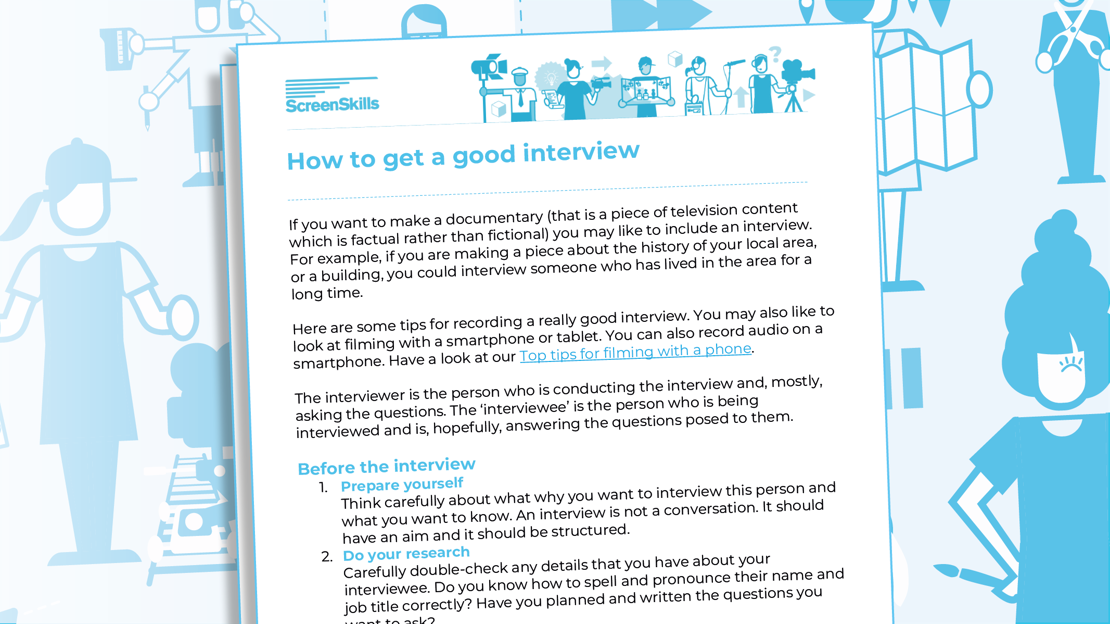If you want to make a documentary (that is a piece of television content which is factual rather than fictional) you may like to include an interview. For example, if you are making a piece about the history of your local area, or a building, you could interview someone who has lived in the area for a long time.
Here are some tips for recording a really good interview. Have a look at our Top tips for filming with a phone to learn how to do this.
The interviewer is the person who is conducting the interview and, mostly, asking the questions. The ‘interviewee’ is the person who is being interviewed and is, hopefully, answering the questions posed to them.
Before the interview
- Prepare yourself
Think carefully about what why you want to interview this person and what you want to know. An interview is not a conversation. It should have an aim and it should be structured. - Do your research
Carefully double-check any details that you have about your interviewee. Do you know how to spell and pronounce their name and job title correctly? Have you planned and written the questions you want to ask? - Prepare the interviewee
Have a chat to them. Make them feel at ease and tell them why you are doing the interview, what you would like to cover and who the audience will be.
During the interview
- Take charge
Make sure that the interviewee is sitting near enough to you and to the microphone or camera. Ask for any background music to be switched off. Ask anyone noisy in the background to please be quiet for a few minutes. Beware of passing traffic, people walking into shot and banging doors. If there is a noise or interruption during a vital answer or the interviewee stutters, don’t be afraid to ask the same question again. You can remove the section with the noise or the mistake when you edit. - Avoid asking questions that can only be answered “yes” or “no”
These are called closed questions. If you do this your interview will be very stilted. For example:
Question. (Q.) "Did you come on the bus?"
Answer. (A.) "Yes."
Q. "Are you pleased with the event?"
A. "Yes."
Q. "Do you like the new shopping centre?"
A. "No." - Ask questions that begin with the five Ws, “who”, “what”, “where”, “when” and “why” (also “how”)
These get longer answers and are called open questions. (Notice the difference between the following examples and those above.) For example:
Q. "How did you get here?"
A. "Well, I came on the bus because there’s nowhere to park next to the shops and I can’t walk far."
Q. "How do you think that the event is going?"
A. "Oh, it’s really good. We’ve had over 300 people already this morning and we expect the same number this afternoon."
Q. "What do you think of the new shopping centre?"
A. "Well it’s okay, but they haven’t got enough car parking spaces really and the range of shops is disappointing.There’s no supermarket and there isn’t a chemist." - Listen
Always listen carefully to the answers. Your interviewee may answer your next question before you have asked it, or your next question might come from something interesting that they say. - Make eye contact
Let the interviewee know that you are engaged with them and with what they are saying. - Avoid umming and ahhing
This distracts prospective viewers of your interview and makes it difficult to edit. - Keep it short and sweet
Don’t record too much you are only making more work for yourself. - Will it make sense?
If you take yourself out of the interview, will the answers make sense on their own?
Before you leave the interviewee, check your recording and play a few seconds back. Make sure that you’ve captured it properly.
Download the PDF
How to get a good interview
